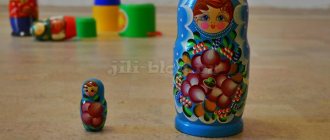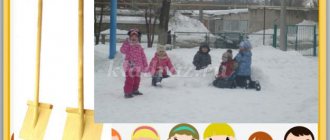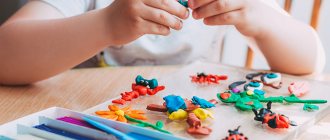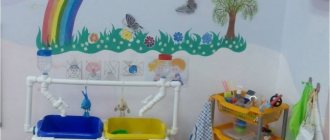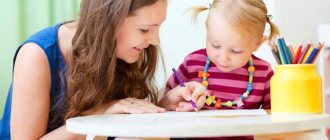Summary of a game lesson in kindergarten. Junior group
Game activity with children of the junior group “Mishka and his friends.”
Description of the material: I offer you a summary of a game lesson with children of the junior group “Bear and His Friends”. This material will be useful to educators and psychologists. The lesson is aimed at developing the basic new formations of social development in young children and will help teachers promote the successful adaptation of children to kindergarten. Goal: creating an emotionally comfortable atmosphere in the group, cohesion of the children's group. Objectives: - Develop self-regulation of students. — Formation of a positive emotional attitude, uniting a group of children Progress of the lesson Teacher-psychologist: Hello, guys! For some reason Mishka didn’t come to visit us. Maybe we can go visit him ourselves. What would you like to drive? Children: “By car, train.” The educational psychologist shows a flat model of a steam locomotive:
“Let's go by train.
I will be a train, and you stand one after another, so we have a train with carriages. Our train set off: Chug - chug, chug - chug The train rushes at full speed. Here we are. Look, there is a house, Mishka probably lives here. Let's knock." Children perform an imitation exercise - knocking with their fists. Mishka appears. Teacher-psychologist: “Say hello to Mishka. What a beautiful house you have. Tell Mishka why we came.” Children: “On a visit.” Bear: “I am very glad to have guests; I’ll show you everything.” Children: “Do you live alone in the house?” Bear: “No, not alone, but guess who lives in my house: He lives in the forest under a Christmas tree, He wears sharp needles. Teacher-psychologist: That's right, Hedgehog. Why are you, hedgehog, so prickly? Hedgehog: This is me just in case! Do you know who my neighbors are? Foxes, wolves and bears! Teacher-psychologist: Guys, do you know what the Hedgehog likes to eat? Milk. Let's give the Hedgehog some milk. (Children bring the saucer to the Hedgehog) Teacher-psychologist: Guys, what does Mishka like to eat? True Honey. Guys, only our Mishka is very sad for some reason. Bear why are you sad? (The little bear shows a small barrel of honey. And says that he has honey, but there is nothing to wash it down with). Teacher-psychologist: Children, let's give our little bear some tea, because he is our guest. (Invites children to the table).
What do you need to take to give Mishka tea?
Educational psychologist: takes one subject at a time, explains what it is called and what it is needed for. -This is a teapot, tea is poured into it. What color is our teapot? Where do we pour the tea? Here in this tea cup, which we put on the saucer. What color is the cup? Children's answers. - That's right blue! And what color is the saucer? Children's answers. -Yellow! Right. (educator-psychologist together with the children puts a cup on a saucer) (Children treat Mishka with tea) Educator-psychologist: Here we are, and we gave the little bear some tea. Our little bear became cheerful! Guys, Mishka says thank you for the children, he brought these cones as gifts. Let's play with the cones and Mishka. Finger game “Pine cones for a bear” The children walked through the forest (two cones lie on the rug, the children slap their palms on their knees) The children collected cones. (children take a cone in each hand) These are the cones (we spin the cones in front of us) We will give it to the bear! This is how the cones knock (we knock the cones on each other) All the kids are amused. These are the cones (we spin the cones in front of us) We will give it to the bear! We'll show the bear the cones (we hold out the cones to the bear) And then we'll hide them behind the back (we hide the cones behind the back) Look for the bear (we shake our shoulders) Where are our cones (the bear is looking for the cones.) And here they are! (children show) Admire the bear, these are the cones! (we spin the cones in front of us.) We put the cones in a bag and give them as a gift.
We recommend watching:
Game activity with children of the younger group. Summary of a game lesson with elements of logorhythmic exercises for children of the 2nd junior group. Summary of a game-lesson in the second junior group. Gift for mom Game - activity for children of primary preschool age
Similar articles:
Didactic game “The doll has a birthday”
Goal: to move from the initial distinction between big and small to the distinction between big by height, by age, by who knows how to do what. A comparison activity that requires reaching a new distinction. In Russian, the distinction big - small simultaneously fixes quality (large or small size) and denotes a quantitative measure for all other qualities (larger in height, width, age, etc.).
As a rule, children use the words big and small to name a set of characteristics. For this reason, with the help of the initial big-small distinction they have, they can build many situations that require building up the child’s system of distinctions.
Progress of the lesson
The teacher reads a letter to the children: “Dear children! Bunny is writing to you - Short Pants from a pine forest. Help me to understand! One day Bear, the owner of the forest, gathered us together and said: “A lot of unrest has begun to happen in our forest, different strangers are coming. It's time to put an end to this. This is what I decided: let all the big animals clear the forest paths and protect the small animals from foreign enemies. And let the small animals put the forest in order, collect garbage and various wood chips into piles. So we will have order in the forest.” That's what they decided on. All the animals went about their business, but about me, the Hare, a dispute arose: which one am I - big or small? The bear says: "Little." And the mouse says: “How small is the Hare? He's so big. Recently he jumped and almost crushed me, Little Mouse.” They argued and argued and never came to an agreement. Help me, guys, figure out: what am I - big or small? Logic of movement using the example of the “Bear” situation: 1. Defining the situation - in problem form, where initially a contradiction is laid down (the hare is considered both big and small at the same time) and unsolvability in action (for the hare). 2. Children try to resolve the situation by choosing one of the poles of the opposition pair: the hare is either big or small. 3. The problem is not resolved, the contradiction deepens due to the fact that positionality is maintained (the hare is both large for a mouse and small for a bear) and the question: what kind of hare really is?
The problem is not solved by a simple choice, but requires the restoration of the original activity situation for its solution.
4. Restoring the situation: what the bear wanted was to restore order in the forest, taking into account which animal can do what.
What was the bear doing? Through acting out, it turns out that he divided all the animals by height. Here we enter the mental plane: distinctions are not something that exists naturally, on things, but something that is determined by the context of the situation and the goals of the speaker and the acting subject.
5. In thinking - semantic deepening and differentiation of distinctions. For example: who is bigger - a baby elephant or an adult hare?
Children get confused and find it difficult to give a definite answer. —And how do we look at it, how do we compare? —By year, by height, size.
Different understandings of big and small are schematized. -Which is better to be - big or small? Children express different opinions: “A little one can do nothing.” “But the big ones can do a lot of things.” The third understanding is fixed: size, age, skills.
6 Return to the situation. Which of the three understandings can help the bear? We choose the third: divide all the animals according to who can do what. As a result, the hare turns out to be a postman - he runs fast.
“The clubfoot bear was walking through the forest, choosing a place for his den.” Lesson notes for preschoolers
A summary of an integrated lesson for children with special needs on design on the topic “Den for a Bear” in the senior group was sent by Daria Aleksandrovna Astakhova , a teacher of the first qualification category of the MBDOU “Child Development Center - Kindergarten No. 17 “Crane”, Verkhny Ufaley.
Goal : To teach children to create a collective composition using Lego constructors based on a unifying image (tree, den); clarification of the abilities of children of senior preschool age to form an emotional attitude towards the hero.
Tasks:
- Reinforce techniques for connecting Lego parts together. Teach children to distinguish between the details of building materials (large and small prisms, plates, cubes, bricks); learn to correlate the sizes of buildings with the sizes of toys; form spatial representations of “high - low”. Lead children to a simple analysis of work.
- To develop the creative abilities of children to evoke positive emotions in the child towards constructive activities and their results. Promote the development of coherent dialogical speech, fine and gross motor skills in children.
- Cultivate the desire to create a beautiful harmonious composition, applying previously acquired knowledge.
Methods : gaming, visual, verbal, practical.
Equipment : illustration of a “bear’s den”, bear toy, Lego constructor.
OOD Plan:
- Introductory part - 3 minutes. The psychological mood of children for joint cognitive and productive activities through the performance of articulatory gymnastics.
- The main part is 20 minutes. Conversation with children. Selection of Lego parts. Independent work of children.
- The final part is 2 minutes. Assessment of children's activities.
The duration of the GCD is 25 minutes.
Progress of the lesson:
Educator : Guys, let's do articulation gymnastics.
This little friend is your cheerful tongue. So that he is dexterous, skillful, So that he obeys you, Do exercises every day in front of the mirror, jokingly! Our fairy tale is a hint for you, After all, the naughty Tongue must do exercises every day. Forgetting about laziness.
Educator : Well done guys. Guess the riddle and you will find out who came to visit us:
Who lives in the deep forest, clumsy, clubfooted? In summer he eats raspberries and honey, and in winter he sucks his paw.
(Children's answers)
Educator : That's right, it's a bear. Who is this bear?
(Children's answers)
Educator : A bear is a large mammal with thick fur that protects its skin. It has sharp claws on its powerful paws, which help it in hunting. A stately, large, shaggy animal, which we always consider clumsy, clubfooted and clumsy, is in fact completely different from our ideas. This is a strong, brave and dexterous forest dweller who can easily show “where crayfish spend the winter,” especially if he is in a bad mood. The bear can swim, run fast, overcome obstacles and climb trees. The bear is omnivorous by nature, loves meat and fish, but he is also not averse to eating honey, berries, grains, tasty grass, roots and fruits. It is he who can find food for himself in the summer; what does a bear do in winter?
(Children's answers)
Educator : That's right, he hibernates. And why?
(Children's answers)
Educator : Where does the bear sleep in winter?
(Children's answers)
Educator : In the den. For the winter, almost all bears go into hibernation in their den, having previously eaten to their fill. If a bear is hungry in the fall, then it wakes up and wanders through the forest in search of food, for which it is called a connecting rod bear. Our bear cannot find a suitable den for himself. He asks us for help. Shall we help the bear and build him a den?
(Children's answers)
Educator : I suggest you build a den for a bear from Lego. What color do you think we will need the parts?
(Children's answers)
Educator : Brown, black, white.
(Children's answers)
Educator : The bear covers the den with branches and it creates a floor. Which Lego piece is right for us for the floor?
(Children approach the table on which there are Lego pieces)
Educator : That's right, a large plate, but what size is it, how do you find out? After all, the bear does not need a large and spacious den, he will freeze in it, and a small one will not suit him, he will not fit into it.
(Children's answers)
Educator : That's right, you need to measure the part according to the bear.
(Children choose the right part by measuring the bear and the plate.)
Educator : Now we have found the right part. Now we will make walls near the den, what parts will we need?
(Children's answers)
Educator Bricks 1x4 and 1x6. That’s right, which fastening method will we use to make our den stable and strong?
(Children's answers)
Educator : Correct, the “Overlap” mount.
(Children begin assembling the walls of the den)
Educator : Well done. The den has a floor and walls, what is missing?
(Children's answers)
Educator : Roofs, we will also choose a plate for that.
(Children make a roof for the den using the selection method)
Educator : You and I now know that the bear chooses a place for a den under a tree. To make our den complete, I suggest making a tree on the roof, what do you think?
(Children's answers)
Educator: Okay, let’s remember what parts a tree consists of. Trunk, branches and crown. Do we need a crown?
(Children's answers)
Educator : That's right, it's not necessary. Since bears need a den for the winter, and in winter the leaves fall from the trees. What Lego pieces will we need to build the tree?
(Children's answers)
(Children collecting wood in the den)
Educator : What a wonderful den we have, I think the bear will be happy. Shall we show the bear his new den?
(Children try the den on a bear).
MAGAZINE Preschooler.RF
Summary of an integrated lesson in the middle group “How bears winter”Prepared and conducted by teacher Arabachyan R. A. Municipal preschool educational institution “Kindergarten No. 225”
Goal: Formation of children's ideas about the peculiarities of wintering bears.
Tasks:
Educational:
- Develop curiosity and educational interest through the discovery of new ideas about animal life.
- Develop creative imagination.
- Develop fine motor skills and accuracy in work.
Educational:
- Cultivate an interest in the life and habits of animals.
- Cultivate a kind attitude towards animals.
- Foster love and caring attitude towards baby animals.
Educational:
- To form an idea in children about the peculiarities of wintering animals.
- Improve skills in working with paints and brushes.
- Enrich children's vocabulary with new words.
- Strengthen the ability to draw round objects. Encourage accurate representation of the subject.
Children's ideas: In winter, the bear hibernates. A mother bear gives birth to cubs in her den. They are blind and naked, they need maternal care. The bear keeps them with her, among her warm wool. She feeds the cubs with her warm mother's milk.
Progress of the lesson
On the surprise table on the left: a model of a winter forest, a hare, a squirrel, a bear, a den.
V.: Guys, today we have a winter forest on our surprise table. What interesting things can we tell about the winter forest?
- Is it good for animals in the forest in winter?
- How do they prepare for winter?
- Where is the bear?
Children's reasoning.
Conclusion: Different animals prepare for winter in different ways: the hare and the fox “put on” a warm fur coat, the squirrel dries mushrooms and collects nuts for the winter, the bear sleeps in a den, which is why we did not meet him in the winter forest
The right side of the surprise table opens: a den in the winter forest.
V.: Guys, look, what is this?
- What is the den made of?
- Let's pop in and see who's there?
Children: There is a bear with cubs!
V.: What kind of cubs, because we know that the bear entered the den alone, and we know that bears sleep in winter. It’s cold, winter, snow everywhere, no food, how will the bear look after them?
Paired interaction of children, enumeration of different opinions.
V.: You guys all have very different and interesting opinions, how can we find out the exact answer to the question of how bear cubs live in a den in winter.
Educational story (from literature): In winter, the bear hibernates. A mother bear gives birth to cubs in her den. They are blind and naked, they need maternal care. The bear keeps them with her, among her warm fur. She feeds the cubs with her warm mother's milk.
You see how many interesting things you can learn from the book. What new did the book tell us about bear cubs?
Conclusion: The cubs feed on the mother bear's milk. They are not cold in winter because the bear keeps them close to her warm fur.
V.: Bear cubs love to play. Let us also turn into little bear cubs and play with them.
Physical education minute:
We are funny guys Our name is bear cubs We love to jump and play, We love to climb and throw.
V.: Guys, today is a joyful day for the mother bear and the cubs. The cubs have a birthday. How can we congratulate them?
Children's reasoning.
Conclusion: It is customary to give gifts on birthdays.
V.: Let us also make gifts for the cubs with our own hands.
Drawing. The theme is “Treats for the bear cubs” of the children’s choice.
V.: You all did very well.
Presentation of gifts.
Q: Guys, what are we in the mood for? Why joyful?
Children's reasoning.
Conclusion: We are in a good mood because we did a good deed. It’s good for us because it’s good for the mother bear and the cubs.
| Next > |
